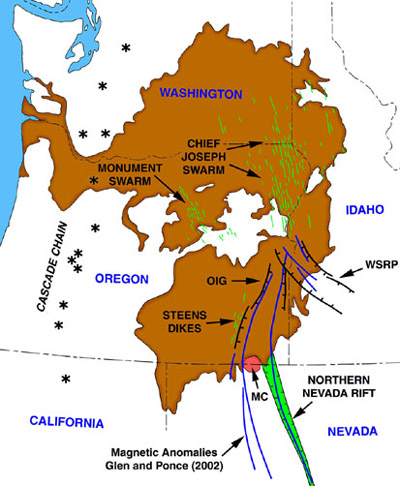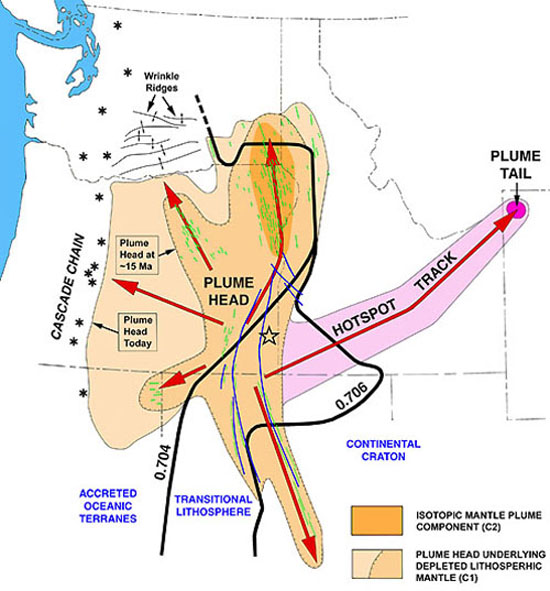November 2004 LIP of the Month
Corresponds to event #1 in LIP record database.
Mantle dynamics and genesis of mafic magmatism in the intermontane Pacific Northwest
Victor E. Camp
Department of Geological Sciences,
San Diego State University,
San Diego, California, USA
vcamp@geology.sdsu.edu
Martin E. Ross
Department of Geology,
Northeastern University,
Boston, Massachusetts, USA
October 25, 2004
See also:
V. E. Camp and M. E. Ross: Radiating Volcanic Migrations: An example from the Pacific Northwest, U.S.A.
http://www.mantleplumes.org/RadVolcMigrations.html
Camp, V.E., and Ross, M.E., 2004, Mantle Dynamics and Genesis of Mafic Magmatsim in the Intermontane Pacific Northwest, J. Geophys. Res., v. 109, no. B8, B8204, d.o.i. 10.1029/2003JB2838. download pdf here (0.7 Mb)
Abstract
The current debate on plume vs. nonplume models partly rests on the presumed role of giant radiating dike swarms in the genesis of Large Igneous Provinces (LIPs). Limited AMS (anisotropy of magnetic susceptibility) studies appear to suggest that at least some of these swarms were generated by the outward propagation of magmatism from a centralized source. The extrusive equivalent of dike propagation should be evident in volcanic migrations along radiating linear trends. Such trends are described here in the intermontane region of the Pacific Northwest. The Columbia Plateau, Oregon Plateau, Snake River Plain, and Northern Nevada Rift compose a single magmatic system containing all the essential characteristics ascribed to a mantle plume genesis. A mobile mantle is delineated by volcanic migrations, divisible into two types: (1) Rapid, radial migrations (~10–100 cm/yr) are associated with impingement and spreading of the Yellowstone plume head along the Chief Joseph, Steens Mountain–Picture Gorge, and Northern Nevada Rift magmatic trends from ~16.6 to 15.0 Ma. (2) Subsequent (post-15.0 Ma), slower migrations (1–5 cm/yr) are associated with shearing off of the plume head, generating the Snake River Plain hot spot track above the plume tail, and with westward asthenospheric drag of the plume head beneath the Oregon Plateau. The plume head provided a melt component to Imnaha and Grande Ronde Basalts. Depleted mantle lithosphere lying above the plume head provided a melt component to Steens Basalt and Picture Gorge Basalt and to younger eruptions of high-alumina olivine tholeiite. The plume head currently resides beneath a broad lithospheric swell, marked by young volcanism, high heat flow, and slow P wave travel times. The periphery of the plume head is delineated by the cratonic margin to the east, a gravity discontinuity and a set of wrinkle ridges to the north, and a prominent belt of young high-alumina olivine tholeiites and active volcanoes adjacent to the Cascade volcanic arc to the west.

New distribution map for the Columbia River Flood Basalt Province. MC, McDermitt caldera; OIG Oregon-Idaho graben, WSRP Western Snake River Plain.

Two-stage spreading model of the Yellowstone mantle plume head, showing (1) the approximate position of the plume head after mpingement and rapid spreading (~15.0 Ma) and (2) its approximate position today after moderate rate spreading associated with asthenospheric drag and counterflow above the subducting plate. The short lines located above the area of first-stage spreading are surficial dikes, and the longer curvilinear lines are the linear magnetic anomalies of Glen and Ponce [2002], which are thought to be buried intrusions or keel dikes. The open star near the Oregon-Idaho border corresponds with the focus of the dike swarms after correcting for block rotation [Ernst and Buchan, 2003]. Wrinkle ridges of the Yakima fold belt in south central Washington [Reidel et al., 1989] appear to be the product of thin-skinned deformation [Watters, 1989], which Mege and Ernst [2001] attribute to peripheral compressive stress at the uplifted edge of plume emplacement. The approximate boundaries of distinct lithospheric domains beneath the plume head are delineated by the 87Sr/86Sr isopleths of Armstrong et al. [1977], Kistler and Peterman [1978], and Leeman et al. [1992]. C1 and C2 correspond to the mantle source compositions.
References
Armstrong, R.L., W.P. Taubeneck, and P.O. Hales, Rb-Sr and K-Ar geochronology of Mesozoic granitic rocks and their Sr isotopic compositions, Oregon, Washington, and Idaho, Geol. Soc. Am. Bull., 88, 397-411, 1977.
Ernst, R.E., and K.L. Buchan, Recognizing mantle plumes in the geological record, Ann. Rev. Earth Planet. Sci., 29, 469-523, 2003.
Glen, J.M.G., and D.A. Ponce, Large-scale fractures related to inception of the Yellowstone hotspot, Geology, 30, 647-650, 2003.
Kistler, R.W., and Z.E. Peterman, Reconstruction of crustal California on the basis of intitial strontium isotopic compositions of Mesozoic granitic rocks: U.S. Geol. Surv. Prof. Pap. 1071, 17p., 1978.
Leeman, W.P. J.S. Oldow, and W.K. Hart, Lithosphere-scale thrusting in the western U.S. Cordillera as constrained by Sr and Nd isotopic transitions in Neogene volcanic rocks, Geology, 20, 63-66, 1992.
Mege, D., and R.E. Ernst, Contractional effects of mantle plumes on Earth, Mars, and Venus, Geol. Soc. Am. Spec. Paper 352, 103-140, 2001.
Reidel, S.P., K.R. Fecht, M.C. Hagwood, and T.L. Tolan, The geologic evolution of the central Columbia Plateau, in Volcanism and tectonism in the Columbia River flood-basalt province, edited by S.P. Reidel and P.R. Hooper, Geol. Soc. Am. Spec. Paper 239, pp. 247-264, 1989.
Watters, T.R., Periodically spaced anticlines of the Columbia Plateau, in Volcanism and tectonism in the Columbia River flood-basalt province, edited by S.P. Reidel and P.R. Hooper, Geol. Soc. Am. Spec. Paper 239, pp. 283-292, 1989.